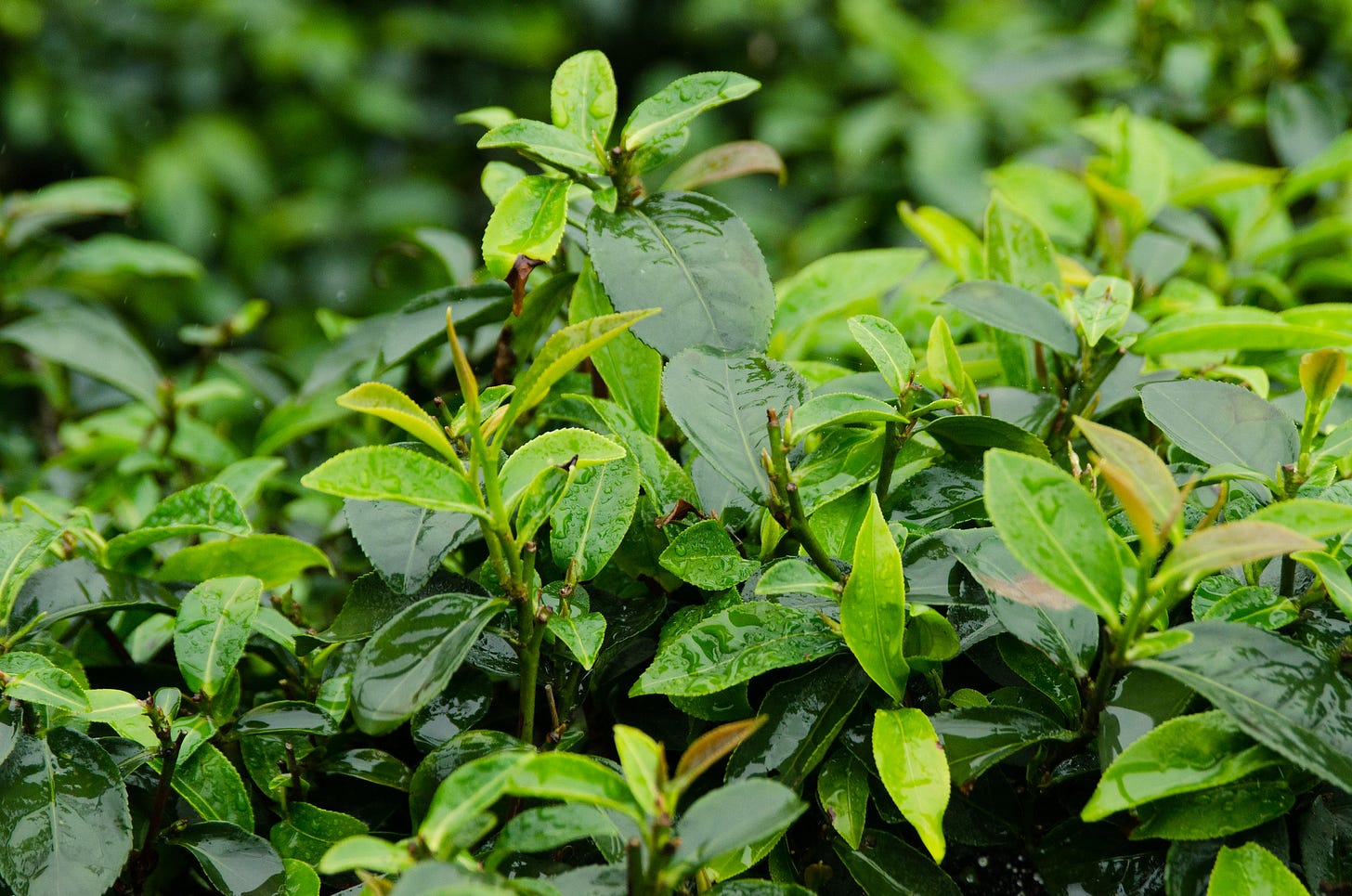Raise your (plucking) standards
Plump yellow buds + how leaf age transforms the tea in your cup.
My talk on the future of the tea industry is this Saturday at Index NYC! Tickets are still available for this tea chat and immersive tasting. I’ll be covering how climate change, labor markets, automation, and processing innovations are changing the meaning and flavor of sustainable tea. Come for the wonky politics, stay for some interesting teas from my private stash that illustrate these changes in action!
I like big buds
The tea: Bogwood Whispers yellow tea, sold by One River Tea. $23 for 25g.
After a newsweek that embodied the phrase “smoke ‘em if you got ‘em,” I needed some solace. A good yellow tea dulls the pain and helps remind me that we’re here on this planet to do something besides spread imperial doom. This graceful and restorative tea is processed similar to Junshan yinzhen, a premium style made only of unopened buds that can get wildly expensive. One River Tea’s batch hails from the lakeshore abutting the famous Junshan island, offering a gentler price for quality material and skillful handling. Yes, it’s pricey. Even moreso with tariffs in place. But a luxurious tea costs only a fraction of a good wine or whiskey, and the times demand occasional treats. Smoke ‘em if you got ‘em.
Yellow teas undergo a sweat lodge treatment that increases sweet and umami flavors and decreases bitter and astringent ones. The result is a uniquely mellow brew with subtle nutty notes, like a green tea with a chiller vibe. Subtlety is key here; the tea’s positive attributes are neither bold nor immediately obvious. It’s a good excuse to take your time, sit with your cup, and pay attention to how the brew impacts your body from steep to steep.
The source: The last time I wrote about One River Tea, I tasted their full range of smoked and unsmoked lapsang souchong styles. This vendor has a knack for finding interesting batches of traditional Chinese teas. The stories of those teas reveal the ever-shifting nature of what “traditional” tea crafting means, as culture and history must reckon with changing tastes, economic necessities, and the brass tacks of sustaining a base of skilled processing experts. Yellow teas like Bogwood hold up better to time than green styles. This April 2024 harvest still has a lot to offer.
To brew: People often say that delicate bud teas like this need cooler water, but here I disagree. Buds are just leaves that haven’t unfurled, and I think they need heat to open up and release their hidden flavors. So I use 5 grams of tea in a 150 milliliter pot with water just off the boil, trickled down the sides of the pot. Steep for half a minute and add another 30 seconds for each subsequent brew. You should get four or five of them. I’d recommend these plump buds to anyone who likes Chinatown almond cookies and Andalusian grilled asparagus draped with Spanish ham. Those are two specific tastes that jut out from my memory; the oily, faintly porky character of this tea is transportive. There’s also a toasty, grainy flavor that transitions to refreshing sweet pea shoots as the brew lingers in my mouth. It starts savory, turns sweet, then leaves me feeling better than before.
Buds, shoots, and leaves: plucking standards and tea leaf chemistry
The leaves in today’s Bogwood Whispers are plucked to a precise and even standard. They aren’t just unopened buds. They’re meaty buds of equal length and thickness that are almost ready to unfurl new leaves. If you examine the wet leaves you can pull back this almost-leaf to reveal a smaller swollen bud within. Tea trees don’t just grow like this. Different branches put out new leaves at all different times. If you want consistently sized and shaped leaves, you need to put in considerable effort to search for them on the plant. Which might make you wonder, why bother? Tea is tea, right?
Plucking standard is the term for what size and age of leaf that pickers should aim for during harvest. Different teas demand individual plucking standards. Silver needle is a white tea composed only of buds, like Bogwood. White peony is a tea from the same plants as silver needle, but instead of just the buds, pickers also pluck the top two tender leaves. Other teas might be made exclusively with larger, more mature leaves.
The conventional wisdom is that unopened buds and young leaves have the highest concentration of caffeine, volatile aromatics, and catechins to make good tea. If that was all there was to it, a clever drinker could simply load their pot with extra tea to mimic the concentration of young, handplucked leaf. But it doesn’t work like that. Each bud, leaf, and stem contributes its own distinct chemical soup to a batch of tea. A consistent plucking standard determines the ideal ratios of those chemicals to make a given style, like picking the right spices from your cabinet for a recipe. You can learn a lot about a tea from its plucking standard, so let’s start at the top and make our way down the shoot.
Keep reading with a 7-day free trial
Subscribe to Leafhopper to keep reading this post and get 7 days of free access to the full post archives.









